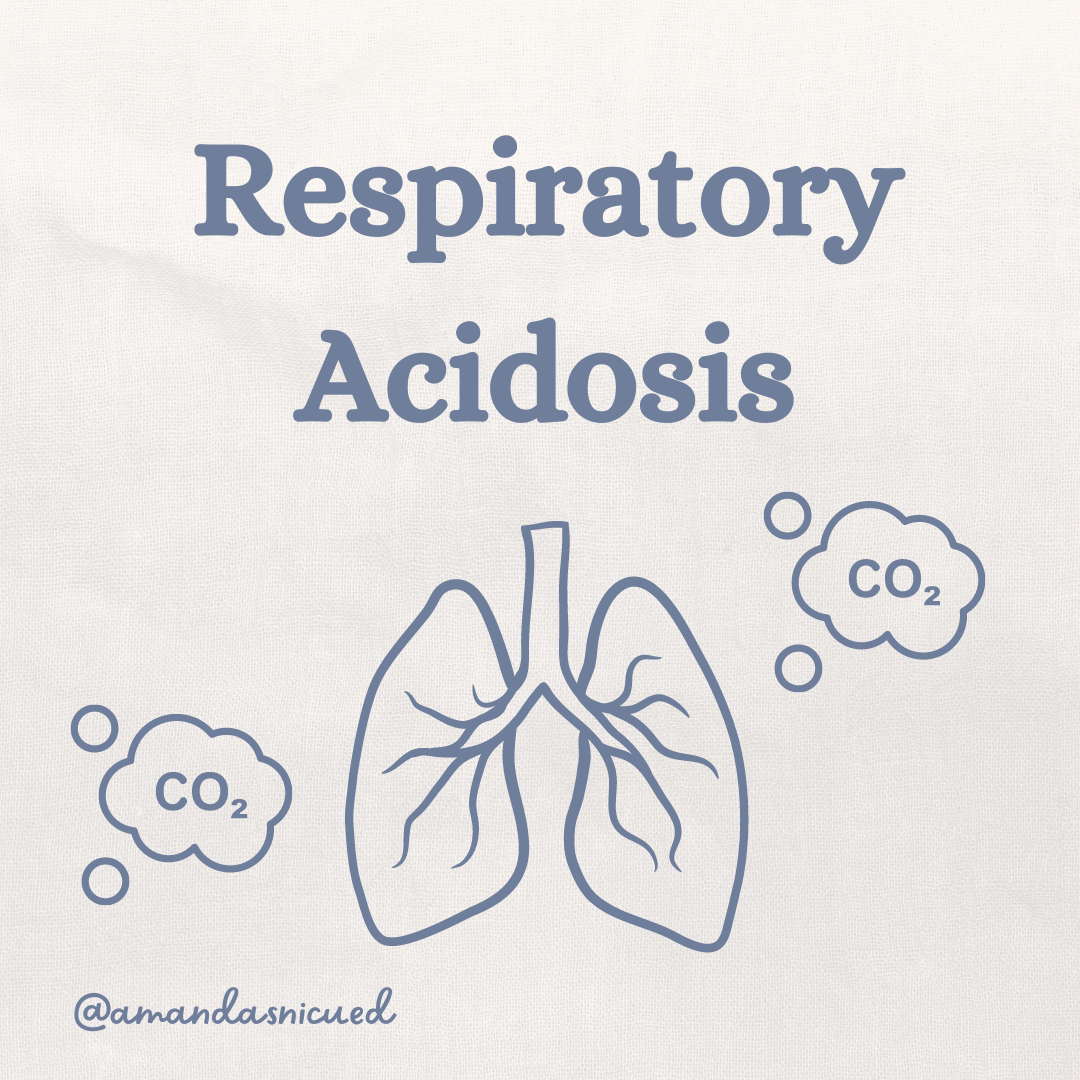Amanda's NICU ED Blogs
RECENT BLOG ARTICLES

Interventions for Respiratory Acidosis
"Respiratory acidosis occurs due to inadequate removal of CO2... the specific intervention depends on the respiratory support the baby is already receiving"
Blood Gas Interpretation & Interventions
One of the most challenging topics in practice and while preparing for the certification exam is blood gas interpretation and determining the appropriate interventions. Let's review it together...
For this week let's focus on interventions to support respiratory acidosis, and we will tackle metabolic acidosis next time.

Need a Refresher on Blood Gas Interpretation? Click Here
Respiratory acidosis occurs due to inadequate removal of CO2. This can result from insufficient alveolar ventilation, airway obstruction, decreased respiratory drive, or ventilation-perfusion (V/Q) mismatch. The specific intervention depends on the respiratory support the baby is already receiving.
When caring for our patients, it's essential to evaluate whether the current therapy provides adequate support based on the clinical exam and correlated blood gas results. Consider the following respiratory assessments:
Is the baby tachypneic, indicating a low tidal volume?
Is there desaturation, suggesting a V/Q mismatch?
Are breath sounds bilateral, and what do they sound like?
Crackles or Rhonchi might indicate pulmonary edema or delayed fetal lung fluid reabsorption.
Is the baby grunting, trying to create their own functional residual capacity?
These assessment findings help provide clues about the babies current status and what they need for support.
Interventions for Respiratory Distress and Acidosis
For a baby who is spontaneously breathing but experiencing respiratory distress (evidenced by grunting, tachypnea, or retractions) and mild respiratory acidosis, CPAP may be a suitable initial intervention. CPAP decreases airway obstruction by splinting the airways open and provides functional residual capacity via PEEP, improving V/Q mismatch. With CPAP, infants' respiratory rates becomes slower and more regular thanks to improved tidal volumes and functional residual capacity.
NIPPV
NIPPV is another respiratory modality for supporting a newborn with respiratory acidosis. It may be used as a primary noninvasive therapy for premature infants with RDS or for infants with moderate respiratory distress who do not require intubation. NIPPV stabilizes the upper airways and prevents end-expiratory collapse, similar to CPAP, but also provides intermittent higher pressures at a set rate. These settings can be adjusted based on clinical exam and blood gas results. In cases of respiratory acidosis, NIPPV can deliver pressures up to 25 cm H2O and rates up to 60 breaths per minute, although rates higher than 40 are uncommon. Higher pressures may even be seen when managing babies with chronic lung disease.
SIMV
SIMV, similar in settings to NIPPV, is an invasive form of ventilation where the baby is intubated. When addressing respiratory acidosis with SIMV or NIPPV, consider ways to increase CO2 excretion. You can increase the rate in increments of 5-10 breaths per minute or raise the PIP by 1-2 cm H2O to increase tidal volume and expel more CO2. Always monitor the clinical exam, blood gas, and transcutaneous CO2 for signs of improvement.
High Frequency Ventilation
For babies requiring high frequency ventilation:
High Frequency Oscillator Ventilator (HFOV): This type of ventilator provides active inspiratory and expiratory pressures using a piston. CO2 removal is largely done by the amplitude but the frequency (Hz) also has influence. To clear more CO2, increase the amplitude (delta P) in increments of 2-5 cm based on blood gas and chest wiggle. Alternatively, wean the frequency (Hz) to enhance oscillation efficacy. Monitor for improvement using chest wiggle, TCOM, and blood gas.
High Frequency Jet Ventilator (HFJV): This provides a very short inspiratory time (0.02-0.03 seconds) at high rates (240-660 bpm, typically 300-420 bpm). HFJV may also use "sigh" breaths at 2-5 breaths per minute to recruit the lungs and prevent atelectasis. To reduce CO2, increase the PIP. If hypercarbia persists despite increasing PIP, raise the rate by 60 bpm. Increasing the PEEP can improve oxygenation as well as reduce CO2.
By following these strategies and carefully monitoring each intervention, we can provide the best respiratory support for our patients.

I always find that reviewing blood gasses on patients at work and discussing the plan with the RTs, NNPs, and MDs helps us have a better understanding of managing respiratory acidosis.
I can't believe it's already June!
Half the year has flown by! Can you believe it? What goals have you set for yourself this year? June is a perfect time to reflect on the past six months and assess your progress. If earning your RNC-NIC or CCRN-N certification is one of your goals, I'm here to help! I offer a comprehensive Certification Review Course and a Study Group where we practice questions together. Both are excellent resources to support you in achieving your goals, and your access never expires! So, you can start preparing even if you're not quite ready to test yet.
Check out the Certification Course
Learn more about the Study Group
Thank you for all the work you do,
Amanda xoxo
Missed my other newsletters? Click here to read them!
References:
Martin, K. (2022). Goldsmith’s Assisted Ventilation of the Neonate (7th Ed). Elsevier
Rüegger, C. M., Owen, L. S., & Davis, P. G. (2021). Nasal Intermittent Positive Pressure Ventilation for Neonatal Respiratory Distress Syndrome. Clinics in perinatology, 48(4), 725–744. https://doi.org/10.1016/j.clp.2021.07.004
Petty J. (2013). Understanding neonatal ventilation: strategies for decision making in the NICU. Neonatal network : NN, 32(4), 246–261. https://doi.org/10.1891/0730-0832.32.4.246
Respiratory and Blood Gas Blogs

Interventions for Respiratory Acidosis
"Respiratory acidosis occurs due to inadequate removal of CO2... the specific intervention depends on the respiratory support the baby is already receiving"
Blood Gas Interpretation & Interventions
One of the most challenging topics in practice and while preparing for the certification exam is blood gas interpretation and determining the appropriate interventions. Let's review it together...
For this week let's focus on interventions to support respiratory acidosis, and we will tackle metabolic acidosis next time.

Need a Refresher on Blood Gas Interpretation? Click Here
Respiratory acidosis occurs due to inadequate removal of CO2. This can result from insufficient alveolar ventilation, airway obstruction, decreased respiratory drive, or ventilation-perfusion (V/Q) mismatch. The specific intervention depends on the respiratory support the baby is already receiving.
When caring for our patients, it's essential to evaluate whether the current therapy provides adequate support based on the clinical exam and correlated blood gas results. Consider the following respiratory assessments:
Is the baby tachypneic, indicating a low tidal volume?
Is there desaturation, suggesting a V/Q mismatch?
Are breath sounds bilateral, and what do they sound like?
Crackles or Rhonchi might indicate pulmonary edema or delayed fetal lung fluid reabsorption.
Is the baby grunting, trying to create their own functional residual capacity?
These assessment findings help provide clues about the babies current status and what they need for support.
Interventions for Respiratory Distress and Acidosis
For a baby who is spontaneously breathing but experiencing respiratory distress (evidenced by grunting, tachypnea, or retractions) and mild respiratory acidosis, CPAP may be a suitable initial intervention. CPAP decreases airway obstruction by splinting the airways open and provides functional residual capacity via PEEP, improving V/Q mismatch. With CPAP, infants' respiratory rates becomes slower and more regular thanks to improved tidal volumes and functional residual capacity.
NIPPV
NIPPV is another respiratory modality for supporting a newborn with respiratory acidosis. It may be used as a primary noninvasive therapy for premature infants with RDS or for infants with moderate respiratory distress who do not require intubation. NIPPV stabilizes the upper airways and prevents end-expiratory collapse, similar to CPAP, but also provides intermittent higher pressures at a set rate. These settings can be adjusted based on clinical exam and blood gas results. In cases of respiratory acidosis, NIPPV can deliver pressures up to 25 cm H2O and rates up to 60 breaths per minute, although rates higher than 40 are uncommon. Higher pressures may even be seen when managing babies with chronic lung disease.
SIMV
SIMV, similar in settings to NIPPV, is an invasive form of ventilation where the baby is intubated. When addressing respiratory acidosis with SIMV or NIPPV, consider ways to increase CO2 excretion. You can increase the rate in increments of 5-10 breaths per minute or raise the PIP by 1-2 cm H2O to increase tidal volume and expel more CO2. Always monitor the clinical exam, blood gas, and transcutaneous CO2 for signs of improvement.
High Frequency Ventilation
For babies requiring high frequency ventilation:
High Frequency Oscillator Ventilator (HFOV): This type of ventilator provides active inspiratory and expiratory pressures using a piston. CO2 removal is largely done by the amplitude but the frequency (Hz) also has influence. To clear more CO2, increase the amplitude (delta P) in increments of 2-5 cm based on blood gas and chest wiggle. Alternatively, wean the frequency (Hz) to enhance oscillation efficacy. Monitor for improvement using chest wiggle, TCOM, and blood gas.
High Frequency Jet Ventilator (HFJV): This provides a very short inspiratory time (0.02-0.03 seconds) at high rates (240-660 bpm, typically 300-420 bpm). HFJV may also use "sigh" breaths at 2-5 breaths per minute to recruit the lungs and prevent atelectasis. To reduce CO2, increase the PIP. If hypercarbia persists despite increasing PIP, raise the rate by 60 bpm. Increasing the PEEP can improve oxygenation as well as reduce CO2.
By following these strategies and carefully monitoring each intervention, we can provide the best respiratory support for our patients.

I always find that reviewing blood gasses on patients at work and discussing the plan with the RTs, NNPs, and MDs helps us have a better understanding of managing respiratory acidosis.
I can't believe it's already June!
Half the year has flown by! Can you believe it? What goals have you set for yourself this year? June is a perfect time to reflect on the past six months and assess your progress. If earning your RNC-NIC or CCRN-N certification is one of your goals, I'm here to help! I offer a comprehensive Certification Review Course and a Study Group where we practice questions together. Both are excellent resources to support you in achieving your goals, and your access never expires! So, you can start preparing even if you're not quite ready to test yet.
Check out the Certification Course
Learn more about the Study Group
Thank you for all the work you do,
Amanda xoxo
Missed my other newsletters? Click here to read them!
References:
Martin, K. (2022). Goldsmith’s Assisted Ventilation of the Neonate (7th Ed). Elsevier
Rüegger, C. M., Owen, L. S., & Davis, P. G. (2021). Nasal Intermittent Positive Pressure Ventilation for Neonatal Respiratory Distress Syndrome. Clinics in perinatology, 48(4), 725–744. https://doi.org/10.1016/j.clp.2021.07.004
Petty J. (2013). Understanding neonatal ventilation: strategies for decision making in the NICU. Neonatal network : NN, 32(4), 246–261. https://doi.org/10.1891/0730-0832.32.4.246
Cardiac Blogs

Interventions for Respiratory Acidosis
"Respiratory acidosis occurs due to inadequate removal of CO2... the specific intervention depends on the respiratory support the baby is already receiving"
Blood Gas Interpretation & Interventions
One of the most challenging topics in practice and while preparing for the certification exam is blood gas interpretation and determining the appropriate interventions. Let's review it together...
For this week let's focus on interventions to support respiratory acidosis, and we will tackle metabolic acidosis next time.

Need a Refresher on Blood Gas Interpretation? Click Here
Respiratory acidosis occurs due to inadequate removal of CO2. This can result from insufficient alveolar ventilation, airway obstruction, decreased respiratory drive, or ventilation-perfusion (V/Q) mismatch. The specific intervention depends on the respiratory support the baby is already receiving.
When caring for our patients, it's essential to evaluate whether the current therapy provides adequate support based on the clinical exam and correlated blood gas results. Consider the following respiratory assessments:
Is the baby tachypneic, indicating a low tidal volume?
Is there desaturation, suggesting a V/Q mismatch?
Are breath sounds bilateral, and what do they sound like?
Crackles or Rhonchi might indicate pulmonary edema or delayed fetal lung fluid reabsorption.
Is the baby grunting, trying to create their own functional residual capacity?
These assessment findings help provide clues about the babies current status and what they need for support.
Interventions for Respiratory Distress and Acidosis
For a baby who is spontaneously breathing but experiencing respiratory distress (evidenced by grunting, tachypnea, or retractions) and mild respiratory acidosis, CPAP may be a suitable initial intervention. CPAP decreases airway obstruction by splinting the airways open and provides functional residual capacity via PEEP, improving V/Q mismatch. With CPAP, infants' respiratory rates becomes slower and more regular thanks to improved tidal volumes and functional residual capacity.
NIPPV
NIPPV is another respiratory modality for supporting a newborn with respiratory acidosis. It may be used as a primary noninvasive therapy for premature infants with RDS or for infants with moderate respiratory distress who do not require intubation. NIPPV stabilizes the upper airways and prevents end-expiratory collapse, similar to CPAP, but also provides intermittent higher pressures at a set rate. These settings can be adjusted based on clinical exam and blood gas results. In cases of respiratory acidosis, NIPPV can deliver pressures up to 25 cm H2O and rates up to 60 breaths per minute, although rates higher than 40 are uncommon. Higher pressures may even be seen when managing babies with chronic lung disease.
SIMV
SIMV, similar in settings to NIPPV, is an invasive form of ventilation where the baby is intubated. When addressing respiratory acidosis with SIMV or NIPPV, consider ways to increase CO2 excretion. You can increase the rate in increments of 5-10 breaths per minute or raise the PIP by 1-2 cm H2O to increase tidal volume and expel more CO2. Always monitor the clinical exam, blood gas, and transcutaneous CO2 for signs of improvement.
High Frequency Ventilation
For babies requiring high frequency ventilation:
High Frequency Oscillator Ventilator (HFOV): This type of ventilator provides active inspiratory and expiratory pressures using a piston. CO2 removal is largely done by the amplitude but the frequency (Hz) also has influence. To clear more CO2, increase the amplitude (delta P) in increments of 2-5 cm based on blood gas and chest wiggle. Alternatively, wean the frequency (Hz) to enhance oscillation efficacy. Monitor for improvement using chest wiggle, TCOM, and blood gas.
High Frequency Jet Ventilator (HFJV): This provides a very short inspiratory time (0.02-0.03 seconds) at high rates (240-660 bpm, typically 300-420 bpm). HFJV may also use "sigh" breaths at 2-5 breaths per minute to recruit the lungs and prevent atelectasis. To reduce CO2, increase the PIP. If hypercarbia persists despite increasing PIP, raise the rate by 60 bpm. Increasing the PEEP can improve oxygenation as well as reduce CO2.
By following these strategies and carefully monitoring each intervention, we can provide the best respiratory support for our patients.

I always find that reviewing blood gasses on patients at work and discussing the plan with the RTs, NNPs, and MDs helps us have a better understanding of managing respiratory acidosis.
I can't believe it's already June!
Half the year has flown by! Can you believe it? What goals have you set for yourself this year? June is a perfect time to reflect on the past six months and assess your progress. If earning your RNC-NIC or CCRN-N certification is one of your goals, I'm here to help! I offer a comprehensive Certification Review Course and a Study Group where we practice questions together. Both are excellent resources to support you in achieving your goals, and your access never expires! So, you can start preparing even if you're not quite ready to test yet.
Check out the Certification Course
Learn more about the Study Group
Thank you for all the work you do,
Amanda xoxo
Missed my other newsletters? Click here to read them!
References:
Martin, K. (2022). Goldsmith’s Assisted Ventilation of the Neonate (7th Ed). Elsevier
Rüegger, C. M., Owen, L. S., & Davis, P. G. (2021). Nasal Intermittent Positive Pressure Ventilation for Neonatal Respiratory Distress Syndrome. Clinics in perinatology, 48(4), 725–744. https://doi.org/10.1016/j.clp.2021.07.004
Petty J. (2013). Understanding neonatal ventilation: strategies for decision making in the NICU. Neonatal network : NN, 32(4), 246–261. https://doi.org/10.1891/0730-0832.32.4.246
hey nurses don't miss out
© Copyright 2024. AmandasNICUEd. All rights reserved. | Terms & Conditions | Privacy Policy Contact: [email protected]


